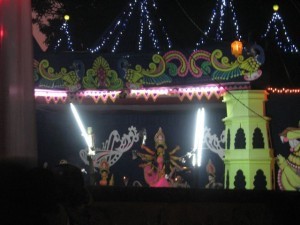Bharungamari – End of the Road
For our final installation, we had to go from the edge of the Bay of Bengal almost to Bangladesh’s northern border with India, a trip of over 350 miles. Along the way we stopped at Humayun’s childhood home, had several flats and picked up a student of Humayun’s from the town where we installed it. After getting the GPS set up at the site he selected, we concluded with a feast at his home, driving by signs of the upcoming Hindu and Muslim festivals, and our own final celebration.
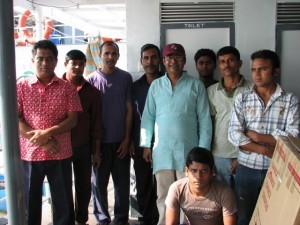
After waking up in the Rupsa River in Khulna, we watched as the Vanderbilt University group studying sedimentation around Polder 32 arrived on Bachchu’s boat. They pulled up alongside and we spent some time catching up with each other’s trips before it was time to hit the road. Our last site is nearly at the northernmost tip of Bangladesh. This one is for tectonics. The 2-km high uplift block of Shillong, is roughly coincident with the Indian state of Meghalaya (Abode of the Cloud). It was the site of a M8.1 earthquake in 1897, although the exact fault that ruptured is uncertain. Our existing GPS indicate that it is moving south at ~7mm/y, but there is a suggestion that it is rotating clockwise, meaning the western end would be moving slower. Our GPS is going in Bangladesh just to the west of Shillong. However, the Brahmaputra River has eroded away the western margin and buried the remnants under sediments. We have to be far enough north to be on the Shillong-Assam block and away from the several faults on its southern side. We settled on the town of Bharungamari. It is literally the end of the road, only a few miles from the Indian border.
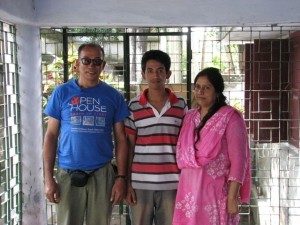
So we set off on a 400 km drive. Along the way, we stopped at Kushtia and visited Humayun’s childhood home and met his sister-in-law and nephew. Then lunch and across the Ganges River. At our first flat tire, we has tea in a small shop – Humayun had them pour boiling water on the glasses for us. At the second it was green cocoanuts. The driver switched to the spare tire while Sarah attracted a large crowd of locals. When we finally got to the hotel it was almost 10pm, about 12 1/2 hours after we left the Kokilmoni. At least it is one of the nicer hotels that I have stayed at in Bangladesh.

The next morning was a more leisurely 8am departure. For breakfast, we were joined by Atiqulla, one of Humayun’s fourth year students who is from Bhurungamari. He scouted the site and would lead us there, the local hospital. We squeezed the extra person into the van and headed north. We got there late morning, scouted out the roof and located a site for the antenna and for the receiver. Getting there meant walking through a hallway with beds containing patients at the hospital. It seems we have had two modes during this trip, either start very early and then have breakfast at noon, or have breakfast first and then have lunch after 4pm. This was the latter. You could tell we were getting worn out. We were having more trouble keeping track of some of the small screws and tools we needed. We started running out of anchors for attaching cables to the wall. Still, we got it done, although it is not our prettiest site.. However, Humayun did a great job with the grounding rod, having a channel cut in the concrete apron around the building, running the wire through a conduit and then recementing over it.
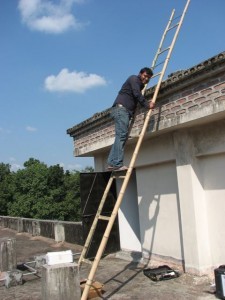
By the time we were done, it was 3:30 and the hospital administrator and some of the staff came to see the site. By the time Humayun finished explaining th purpose of the GPS, we were more than ready to get some lunch. What I didn’t know was that we were invited to Atiqulla house for lunch. We went to the house of his extended family, parents, siblings and nieces and nephews where we were served a feast. The five of us ate while the family and a large group of neighbors looked on and chatted with us. We had chicken, squab and beef along with boiled and pilao rice, paratha (bread), vegetables, dal (lentils), and cucumbers. A veritable feast and a good ending for the last GPS installation.
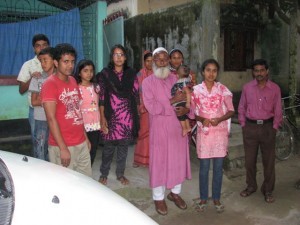
We stuffed our selves and headed back to Dhaka, staying overnight at Bogra, 4 hours away. Along the way we passed celebrations of Durga Puja, the largest Hindu festival in Bangladesh, and lots of cattle and other animals being transported for Eid ul-Azha, the feast of the sacrifice, to be celebrated this weekend. After arriving in Bogra, we celebrated with a beer at the first bar I’ve ever seen in Bangladesh.
